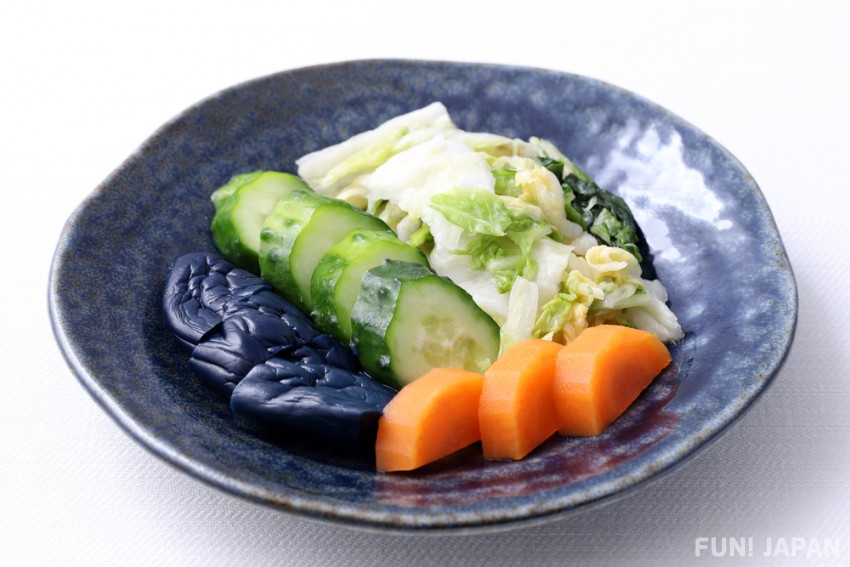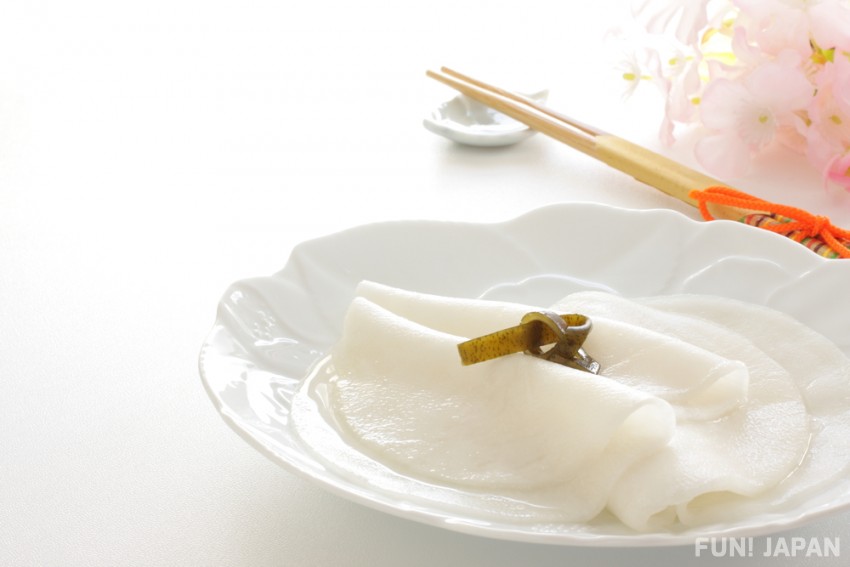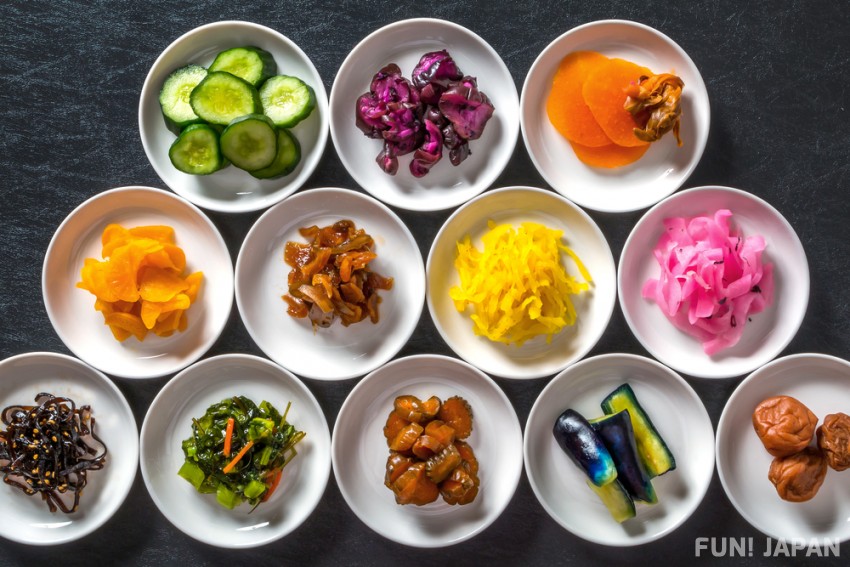
Pickles, or 'tsukemono' (漬物) in Japanese, are made by pickling various ingredients in various pickle liquid or pickle mixtures such as salt, vinegar, sake lees, miso, rice bran, etc. It is served in small bowls with Japanese set meals and rice bowls, is used as an ingredient in rice balls, and is used as an accompaniment to rice. Vegetables that are rich in dietary fiber and full of umami are addictive once you eat them! In this article, we will introduce Japanese traditional food, tsukemono!
The history of tsukemono is old! Traditional Japanese food, pickles (tsukemono)

Tsukemono or pickles are an essential part of the Japanese dining table. Its history is long and old.
The first record of tsukemono in Japanese history appears in the Nara period (710–794). Mokkan (writing on pieces of wood) from the Tenpyo period (729-749), when tsukemono was at its peak, records gourds and green vegetables pickled in salt. After that, the culture of the mainland Asia was introduced, and seasonings such as sake and miso began to be made. There are also records of pickled lees and "suzubori", which is considered to be the original form of modern takuan (pickled radish). Surprisingly, the prototype of the current tsukemono had already been completed in this era! After that, in the Muromachi period, pickles were called "konomono" (香の物), which means "fragrant items", and in the Edo period, the tsukemono industry was born as the number of restaurants and eateries increased, even books on how to pickle were also published.
Shibazuke and senmaizuke from Kyoto, iburi-gakko from Akita, and takana-zuke from Fukuoka are now popular local tsukemono all over the country and have become standard souvenirs. Surprisingly, there are over 600 types! From the next part, we will introduce various pickling methods used for famous local pickles!
The important point of making tsukemono is pickle method! Introduce ingredients and how to pickle

Just like rice and miso soup, pickles are an essential part of Japanese cuisine.
However, even if you call them all tsukemono, various seasonings such as salt, vinegar, miso, and soy sauce are used, and there are fermented pickles such as rice bran pickles and thick pickles such as light pickles (pickled plums, pickled red ginger, fukujinzuke) that are soaked in a seasoning liquid such as soy sauce or vinegar for a short period of time.
The taste and flavor of pickles differ depending on how they are pickled, so if you're buying them as souvenirs, be sure to check not only the ingredients but also how they're pickled too!
Shiozuke (塩漬け): Salt Pickling
Method of making pickles that preserve vegetables using the simplest salt and water. It is one of the oldest methods, and there are two ways: salt pickling, which is eaten as it is, and salt-preservation, which is a method of preserving the ingredients. In the case of salted pickles that are eaten as they are, the most standard ones are salted cucumbers and salted Chinese cabbage. Salt-preserved foodstuffs can be marinated in seasonings such as soy sauce and vinegar.
The most popular souvenirs are Nozawana pickles, Takana pickles, Hiroshimana pickles, pickled plums, pickled chrysanthemums, and pickled cherry blossoms.
Suzuke (酢漬け): Vinegar Pickling

Unfermented pickles pickled in vinegar. It retains its texture and gives it a tangy flavor. The most famous example is pickled ginger called 'gari', which is often served with sushi and fried rice. The fresh, sweet and refreshing flavor is perfect for palate cleansing. In addition, rakkyo-zuke, which is often served with curry and rice, and senmai-zuke from Kyoto are also famous.
Misozuke (味噌漬け): Miso Pickling
Salt-preserved vegetables pickled in miso. In Japanese markets such as Nishiki Market in Kyoto, it is often marinated in barrels. Miso-zuke (Kinkon-zuke), Inro-zuke, and Yokan-zuke are famous.
Kasuzuke (粕漬け): Sake Lees Pickling
"Sake lees" is made after squeezing sake. Salt-preserved are pickled in this sake lees, and not only can you use up what would otherwise be thrown away, but you can also preserve seasonal vegetables for a long time. Nara-zuke, wasabi-zuke, Sankai-zuke, and Moriguchi-zuke are famous.
Nukazuke (ぬか漬け): Rice bran pickle
"Rice bran" is a powder that is made by tearing the pericarp and seed coat during the polishing of "brown rice". Nukazuke is a by-product of rice bran pickled with vegetables such as cucumbers, eggplants, radishes and turnips. Well-known pickles include takuan-zuke, iburi-gakko, Ise-takuan, hino-zuke, kan-zuke, yamakawa-zuke, and nuka-miso-zuke.
Common tsukemono (pickles)

| Umeboshi (梅干し) | The most common pickle, it is often used as an ingredient in rice balls and lunch boxes in Japan. Pickles made by salting plums, drying them in the sun, and then soaking them in plum vinegar to soften the flesh. Red perilla leaves are often added to plum vinegar to give it a red color. |
| Beni Shoga (紅生姜) | Bright red and often served with yakisoba or okonomiyaki, this shredded ginger gets its color from the salt water leftovers from the umeboshi. |
| Takuan (たくあん) | A pickled daikon radish pickled in rice bran and salt, often served with rice. It is a typical nukazuke that uses rice bran. |
| Fukujinzuke (福神漬) | Japanese pickles made by pickling daikon, lotus root, and other vegetables in a seasoning liquid made from soy sauce, sugar, and mirin. Served with curry. |
Salt concentration of umeboshi (pickled plum)

The most important thing in making pickles is the salt concentration. Salted vegetables, which are the basis of pickles, are usually salted at a salt concentration of 15% or more to prevent spoilage by microorganisms and increase storage stability.
Umeboshi, which is a representative pickle, has a general salt concentration of 10 to 15%. Basically, the more salt you use, the higher the shelf life, and the less salt you use, the lower the shelf life. Umeboshi with a low salt concentration of 10% or less should be eaten quickly because they contain a lot of water and are prone to spoilage.
On the other hand, if the salt concentration is 20% or more, it will keep well, but if you don't like strong flavors, you may find it too salty. Also, if you store ume plum with a high salt content for a long period of time, the salt will seep into the ume and cause the ume to wrinkle, so be careful.
How to enjoy tsukemono

When you order a Japanese meal or a bento box in Japan, pickles are often served with the rice. It is neither a main dish nor a side dish, but rather an accompaniment to rice. If you eat it with white rice and side dishes, it will make your meal more delicious, and it will also help you with nutritional supplements such as vitamins, dietary fiber, and minerals.
You can find various kinds of tsukemono pickles in Japanese restaurants, supermarkets, and convenience stores in Japan. They keep well, so pickle shops always have the best products!

Comments